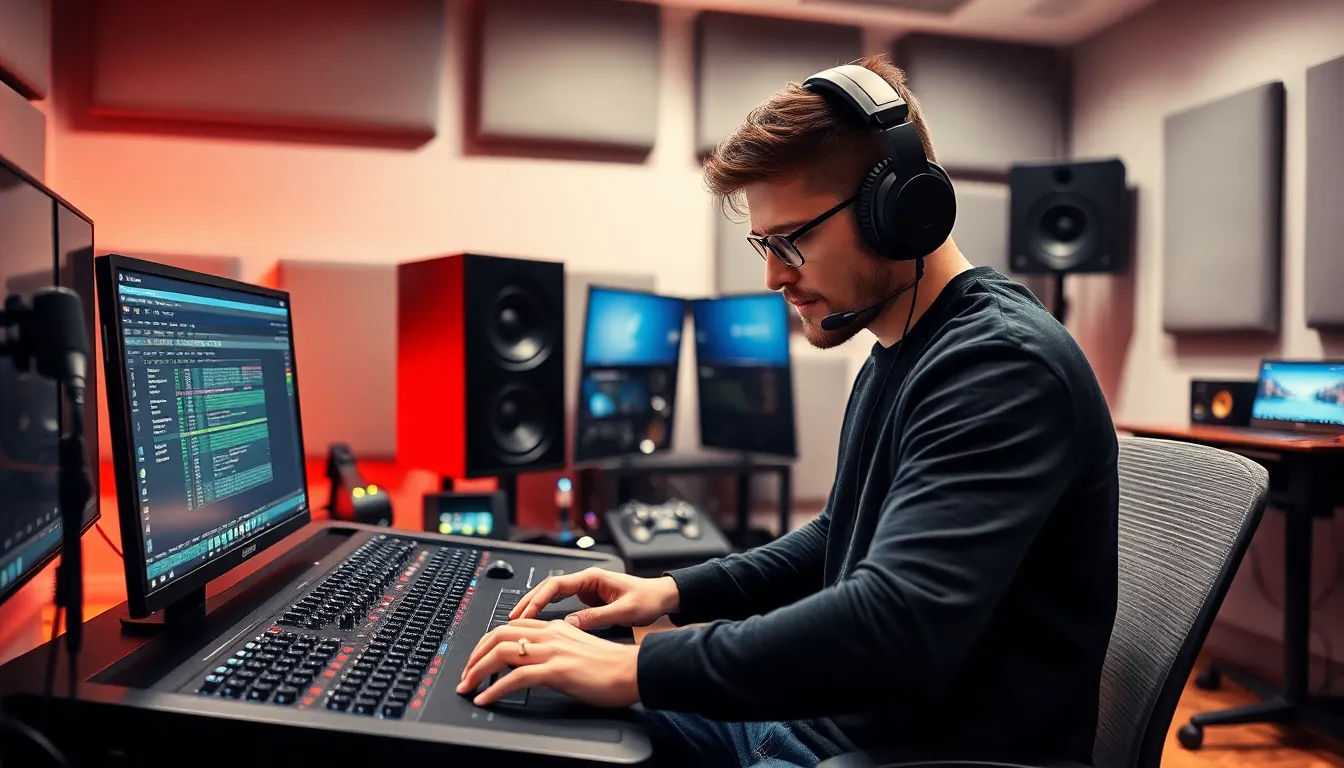In the world of video games, sound design is the unsung hero, lurking in the shadows while players battle dragons or race through futuristic cities. It’s the secret sauce that transforms pixelated graphics into an immersive experience. Without those heart-pounding soundtracks and spine-tingling effects, gaming would be like watching a movie on mute—confusing and a bit tragic.
Imagine slaying a zombie without the satisfying squelch or racing through a track without the roar of engines. Sound design doesn’t just add flair; it creates emotions, builds tension, and sometimes even makes players jump out of their seats. So, let’s dive into the fascinating world of sound design in video games and discover how those audio wizards craft the magic that keeps gamers coming back for more.
Table of Contents
ToggleOverview of Video Game Sound Design
Video game sound design encompasses the creation and integration of audio elements that enhance player engagement. It includes sound effects, ambient sounds, and music that collectively immerse players into the game world. Designers utilize a variety of techniques to produce auditory experiences, thereby making gameplay more compelling.
Sound effects serve as crucial identifiers, signaling actions such as jumps, hits, or item pickups. Each sound adds depth and connection to in-game actions, reinforcing player responses. Designers often record real sounds or create digital stimuli to achieve the desired effects, leading to realistic audio that resonates with players.
Ambient sounds create atmospheric layers, enhancing the environment’s authenticity. Whether players traverse a bustling city, explore a haunted forest, or venture across alien landscapes, these background sounds transport them into the setting. The careful selection of sounds helps evoke emotions and establish the tone of scenes.
Music plays a pivotal role in shaping a player’s emotional experience. Theme compositions may shift based on gameplay intensity, heightening tension during battles or fostering calm during exploration. Each score aligns with the narrative and visual elements, creating a cohesive and memorable experience for players.
Collaboration among sound designers, composers, and game developers ensures that audio elements align with visual components. Frequent iteration allows teams to refine and perfect sound elements, making adjustments based on player feedback. Players benefit from this synergy, as sound design significantly enhances their connection to the game.
Importance of Audio in Gaming

Audio serves as a fundamental aspect of gaming, significantly impacting the player’s experience. Quality sound design creates an immersive environment that draws players deeper into the game world.
Enhancing Immersion
Immersion in gaming relies heavily on audio elements. Authentic sound effects provide players with cues for in-game actions, making gameplay feel more real. Ambient sounds, such as the rustling of leaves or distant city noise, create a sense of place, reinforcing the game’s atmosphere. Effective audio design allows players to navigate challenges using sound alone, adding to the overall gaming experience. Acoustic elements guide players through immersive narratives, enhancing the relationship between the narrative and gameplay mechanics.
Emotional Impact on Players
Audio has a profound emotional impact on players. A well-composed soundtrack can evoke feelings of excitement during high-stakes moments or calmness during exploration. Dynamic music shifts alongside gameplay intensity, creating a deeper emotional connection. Sound design can trigger nostalgic feelings or apprehension based on the contexts presented. Designers strategically use sound effects to amplify tension, guiding players through emotional highs and lows, ultimately enriching the storytelling experience.
Key Components of Sound Design
Sound design in video games comprises several critical elements that work together to create a rich audio experience. Each component adds depth and immersion for players.
Sound Effects
Sound effects play a vital role in gameplay. They provide immediate feedback for actions, ensuring players understand their impact. From footsteps crunching on gravel to weapons firing, these sounds enhance realism. High-quality sound effects contribute to the game’s overall polish and immersion. The integration of environmental sounds, like rustling leaves or distant thunder, establishes a believable atmosphere. Designers often use layered soundscapes to create dynamic audio experiences that change based on in-game events.
Music Scoring
Music scoring serves to evoke emotions and enhance player engagement. Dynamic compositions adapt to gameplay situations, heightening excitement during battles or creating tension during explorative phases. Composers craft themes that resonate with character arcs and narratives. Memorable soundtracks aid in creating iconic gaming moments, often becoming synonymous with the game itself. Looping melodies and transitional cues provide seamless audio experiences, ensuring that music supports rather than distracts from gameplay.
Voice Over
Voice over work adds personal depth to characters and storytelling. Skilled voice actors infuse personality and emotion into their performances, making characters relatable. Dialogue drives narrative engagement, often guiding players through the story. High-quality recording techniques ensure clarity and immersion, while syncing with animations enhances realism. The interplay between voice acting and sound effects creates a cohesive experience, where every line contributes to the player’s emotional journey.
Techniques in Video Game Sound Design
Video game sound design employs various techniques to enhance player experience. These methods contribute to the overall immersive quality of the gaming environment.
Foley Art
Foley art involves recreating everyday sounds to add realism to the game. This technique uses physical props to mimic sounds like footsteps or rustling clothing. Artists capture these sounds in a studio, ensuring they match the actions depicted on screen. For example, the sound of a sword unsheathing may incorporate the noise of a metal object sliding against leather. The attention to detail in Foley art enriches the auditory experience, making gameplay feel more lifelike.
Spatial Audio
Spatial audio creates a three-dimensional sound environment that enhances immersion. Players perceive sounds as coming from specific directions, replicating real-world auditory experiences. This technique employs various audio technologies, such as binaural recording, to simulate how sounds interact in space. When a character moves, sounds shift dynamically, guiding players and increasing engagement. Spatial audio significantly improves gameplay by helping players locate in-game elements through sound cues, making the world feel more cohesive.
Dynamic Soundscapes
Dynamic soundscapes adapt audio elements in response to gameplay conditions. These soundscapes shift based on player actions, environmental changes, or game events. Different musical scores or sound effects may trigger depending on the intensity of a battle or the serenity of exploration. For instance, music may swell during a climactic moment or fade during quiet exploration. This fluidity fosters emotional connection and reinforces narrative themes, making every gaming session unique and memorable.
Emerging Trends in Video Game Sound Design
Emerging trends in video game sound design constantly reshape player experiences. Innovative practices enhance immersion and engagement in gaming.
Adaptive Sound Design
Adaptive sound design responds to player actions in real-time. Audio elements change based on game scenarios, creating a dynamic sound environment. Music transitions adapt in intensity, reflecting gameplay moments. For example, calmer scores accompany exploration, while intense compositions heighten during combat. Players notice immediate feedback through sounds that align with actions, enriching overall involvement. This customization deepens the emotional connection with the narrative. The seamless blend of soundscapes creates a personalized gaming experience, making each player’s journey unique.
Use of Artificial Intelligence
Artificial intelligence transforms sound design in video games. AI algorithms analyze gameplay data to generate contextually appropriate audio responses. For instance, character interactions receive tailored voiceovers that reflect player choices. Procedural audio generation creates vast soundscapes without extensive manual input, enhancing efficiency. Furthermore, AI assists in predicting player behavior, allowing for preemptive audio cues to guide actions. This technology streamlines the design process, freeing sound designers to focus on creativity. Ultimately, AI fosters richer and more immersive audio experiences, illustrating its potential in revolutionizing game soundscapes.
Sound design is a vital component of video games that cannot be overlooked. Its ability to create immersive experiences and evoke emotions significantly enhances gameplay. Interestingly, the same principles of audio immersion are now being applied in the online casino australia market, where realistic sound effects and atmospheric audio help recreate the thrill of land-based casinos in a digital space.
As technology advances, the possibilities for innovative sound techniques continue to expand.
Players are now treated to dynamic soundscapes that adapt in real-time, further deepening their connection to the narrative. With the integration of AI and adaptive sound design, the future of video game audio holds exciting potential.
Ultimately, the artistry behind sound design not only enriches the gaming experience but also shapes how stories are told within interactive worlds. As players engage with these audio elements, they discover a deeper appreciation for the craft that brings games to life.




